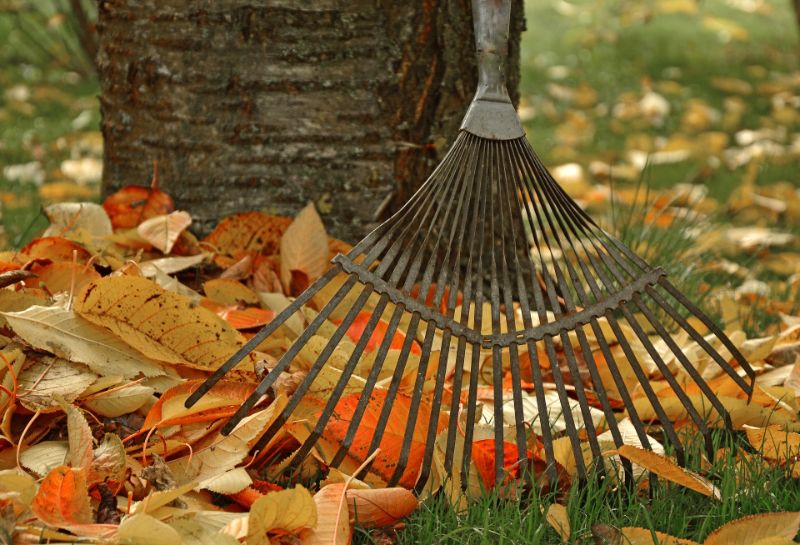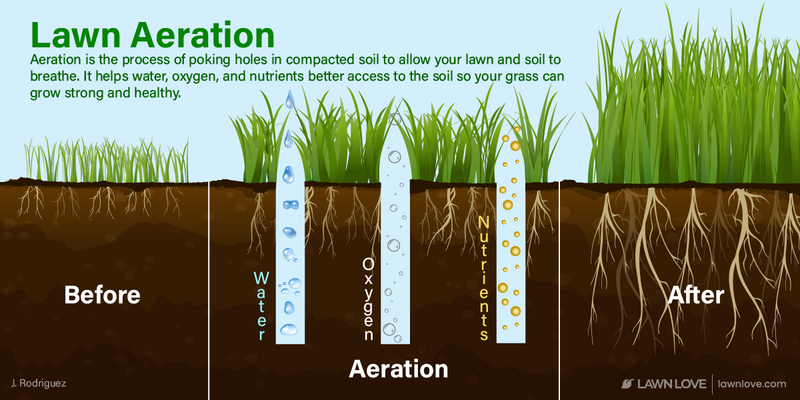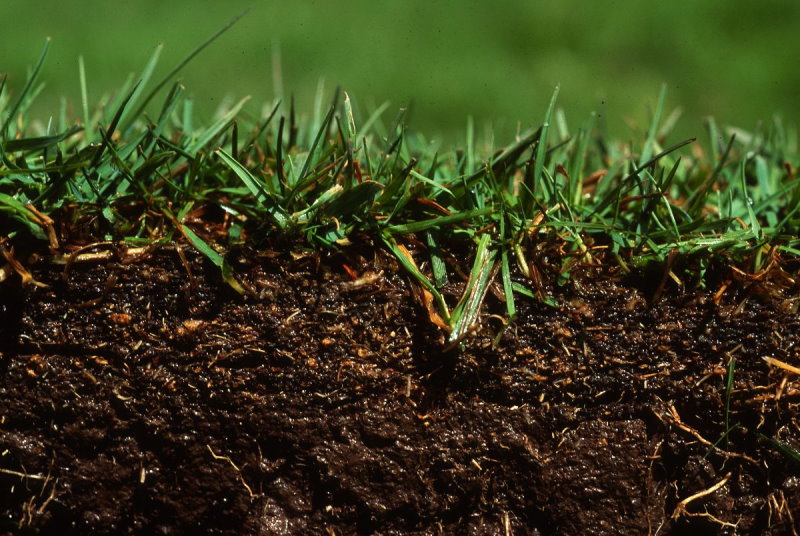
As the air takes on a chill and football season kicks off, you’ll need to come up with a game plan for winterizing your lawn to ensure it survives the cold winter and is primed for the spring growing season. A proper lawn care regimen is critical. Follow this fall lawn care checklist for Bridgeport.

1. Rake vigorously
New England’s fall could be designated the season of colors. However, those magnificent maples and other deciduous trees eventually blanket your lawn with their gorgeous leaves. You’ll probably need to rake at least every three to four days to avoid mounds of leaves that will:
- Block sunlight, water, and other nutrients from penetrating the soil
- Possibly cause a disease or lawn decay
- Invite unwanted pests
- Stunt new grass growth
Pro Tip: Instead of raking, consider mulching the leaves into small enough pieces to allow for decomposition. Also, be sure the lawn is dry Otherwise, ruts can result.
If your property has many trees, a leaf blower might be a more efficient way to handle the job. There are several options to consider, such as corded and battery-powered blowers.
Check with your town’s regulations or contact the Noise Pollution Clearinghouse for local guidelines before using any power tools, especially a blower. Your area could possibly be restricted to certain hours.
Finally, don’t trash those leaves! If you don’t already have one, start a compost pile and add in the leaves. Leaf compost contains nutrients and carbon, an essential component for photosynthesis which aids in lawn growth and health.

2. Dethatch if needed
If your lawn feels spongy when you walk on it, has excessive weeds or patchy brown spots, you might have a thatch problem.
To determine if you need to dethatch:
- Slice out about a 2-inch thick wedge from your lawn
- Measure the brown or spongy layer between the soil surface and the base of the grass blades
- If the layer is more than 1/2 inch thick, it’s time to dethatch
Thatch is an intermingled layer of dead and living organic matter collected between the soil and grass. A layer less than ½ inch actually acts as a blanket for your lawn and protects against temperature fluctuations, drought and weeds. However, if allowed to remain and grower thicker, it can lead to:
- Grass decay and fungal diseases
- Lessen the flow of air, water, and fertilizer
- Influx of unwanted insects
How to prevent thatch buildup:
- Apply the proper fertilizer
- Apply pesticides when needed
- Mow your grass at the proper height
- Maintain the right mowing frequency
- Maintain proper amount of nitrogen
- Have the proper irrigation practices
What’s dethatching? It’s the removal of the excessive layer of thatch with powerful, energetic raking.
Dethatching methods include:
- Manual dethatcher — best for small lawns with a slight thatch problem; labor intensive
- Electric/corded thatcher — ideal for medium-sized lawns with a mild to medium problem
- Power rake — works well for large, dense lawns with a significant thatch problem
- Verticutter — extremely efficient for large lawns with a very serious thatch problem
Pro Tip: The best time to dethatch your cool-season grass is early fall, while the grass is actively growing, soil is moist and taking in nutrients, and can recover from injury quickly.

3. Aerate so your soil can breathe
If you want your grass to grow thick and healthy, aerate after you’ve removed the thatch. The process of aeration removes small plugs of soil to create small holes. This loosens and opens up the soil to allow water, oxygen, and other nutrients to tunnel to the roots.
Fall is the ideal time to aerate cool-season grasses. The second best time is spring.
You need to aerate if you have:
- Heavy foot, vehicle or large equipment traffic
- Dense, thick, clay soil
- Compacted soil
Benefits of aeration include:
- Increases circulation and the flow of air, water, and nutrients
- Breaks up soil and reduces compaction
- Stimulates root growth
- Reduces the need for fertilizer and pesticide
- Stymies the occurrence of disease, fungus, and pests
How to aerate:
- Spike- or solid-tine aerators work best for minimal compaction
- Core aerators are well-suited for advanced damage or compaction.
While you could rent a core aerator from a garden center, it’s costly to do so and requires a certain skill level and energy. Give yourself a half-time break and call in a pro for this task.

4. Overseed
Overseeding is a relatively simple process that assists in replenishing your lawn with new, healthy growth. You aren’t creating a new lawn, but rather, filling in thinning areas or bald spots in your lawn.
The optimum time is early fall when the air temperatures are cooler, which provides ideal conditions for germination. Also, the grass retains moisture and the seeds will thrive before the frigid winter temps and summer heat.
How to overseed:
- Mow your lawn to about 2 inches high
- Dethatch
- Aerate
- Apply compost
- Perform a soil test
- Fertilize, if necessary
- Spread seed
- Rake gently to spread seed
- Water daily
- Seeds should be moist, not soggy
Reasons why you should overseed:
- Reduces weeds
- Fills in bare spots
- Improves overall lawn density
- Energizes the lawn’s health and color

5. Fertilize, but perform a soil test first
Don’t just assume your lawn needs fertilizer. You’ll need to do a soil test first to determine the exact nourishment your specific cool-season grass needs.
Lawns require a mixture of nitrogen, phosphorus, and potassium. This is referred to as the N-P-K ratio. On your fertilizer bag it might say “15-0-10,” which means it contains 15% nitrogen, 0% phosphorus, and 10% potassium.
How to conduct a soil test:
- Dig about 3 inches into the soil with a small shovel
- Gather 10-15 samples
- Combine the samples from the same area
- Place in a sealed, plastic bag
- Do not collect wet soil
You can obtain a soil kit from your local extension office who will provide you with explicit directions.
Now that you have the results of your soil test, you know what to look for in your fertilizer.
Fertilizer is important because it;
- Promotes grass density and growth
- Stymies weeds
- Promotes a rich green color
- Reduces the need for pesticides
- Encourages heat, drought, and cold resistance
- Reduces water runoff
You can spread fertilizer via a drop spreader for targeted applications, or a broadcast spreader for a large area. Liquid or water-soluble fertilizers are also available but do not provide an even application.

6. Get rid of wicked weeds
Weeds appear in many shapes and sizes and invade your landscape. They often camouflage as pretty little flowers. But don’t be deceived!
Here’s why those wicked weeds need to be controlled:
- Weeds push the good plants out of the way
- They prevent grass and other plants from thriving
- Weeds harbor unwanted insects
- They impede water flow
The following list includes some of Connecticut’s most common weeds:
- Crabgrass
- Henbit
- Creeping Charlie
- Nutsedge
- Prickly lettuce
- Broadleaf plantain
- Dandelion
Apply a pre-emergent herbicide to prevent a spring invasion. However, if they have invaded your fall landscape, hit them with a post-emergent herbicide.
Before a pre-emergent herbicide application, the ground temperature should be 55 degrees for at least 48 hours. The ground should be dry with no rain in the forecast.
Apply a post-emergent herbicide when the daytime temperature is under 85 degrees but above 55 degrees for at least three consecutive days. Do not apply if rain is predicted, and wait at least three days before mowing.

7. Do your last mow of the season
If the air temperature remains between 55 and 75 degrees, your cool-season grass continues to grow. Once it gets below 55, you’ll notice the decline in growth. However, it’s imperative to mow your lawn before Old Man Winter blows through. Unsightly matted grass becomes susceptible to diseases like snow mold.
Follow these recommended mowing heights for cool-season grasses:
| Kentucky bluegrass | 2.5-3.5 inches |
| Perennial ryegrass: | 1.5-2.5 inches |
| Tall fescue | 2-3 inches |
| Fine fescue | 2-2.5 inches |
Always follow the one-third rule of mowing. Never cut off more than one-third of the grass blade in each mow. Cutting grass short stresses the turf and weakens its luster.

8. Water is still required
Don’t let that nip in the air deter you from watering your lawn. To promote a healthy root system and verdant turf come spring, you’ll need to continue watering. Water deeply, but infrequently, until the first freeze.
If you notice these signs, your lawn requires water:
- Footprints after walking on the grass
- Wilted, blue-grayish grass blades
Your lawn needs about 1 to 1 ½ inches of water weekly. If water continually flows down your driveway and into the street, you are overwatering. Adjust your sprinklers accordingly.
To measure your the water output from your sprinklers, perform the tuna can test:
- Place small tuna or cat food cans around the lawn (one near the sprinkler head, one in the middle, and another near the perimeter)
- Run your sprinkler system for 15 minutes
- Measure amount of water in each can
- Add the total and divide by 3 to get the average output
Or, simply do the screwdriver test:
- Run the sprinkler system for 15 minutes
- If a screwdriver easily slides 6 inches into the soil, then 15 minutes is adequate
Remember to water early in the morning, before 10 a.m. Watering in the evening provides perfect conditions for fungus and disease.

9. Shut down your sprinkler system
With winter on the way, you’ll need to shut down your sprinkler system before a freeze. Water left in the system could result in cracked pipes and broken sprinkler heads. Or worse, your entire system might break down!
There are three methods to winterize your sprinkler system:
- Manual drain
- Automatic drain
- Blow-out method
We have provided some general instructions on how to shut down your system. First, you will have to determine exactly which type of valves are in your system. Second, check your manual for explicit instructions. And, lastly, if you can’t find the manual, check out the company’s website.
Manual drain:
- Turn off main water valve
- Open all drain valves
- Allow any excess water to drain out
- Close all drain valves
Automatic drain:
- Shut off water supply
- Close main valve
- Open drain cap
- Drain off water
Blow-out method:
- If not done properly, this method can be dangerous, so we highly recommend you call a professional.

10. Get the rest of your yard ready for winter
Before Mother Nature, not so gently, lays her winter blanket of snow on your Bridgeport landscape, you need to pre-empt her with these simple steps:
- Trim and prune branches and stems
- Divide perennials, giving roots more space to develop
- Wrestle out weeds
- Remove all dead plants and any debris
- Spread manure, compost, and other soil supplements to enrich the soil
- Add mulch for insulation
- Wrap your shrubs with a plant tent to shield against ice and snow
Tackle your fall lawn care
If you want to spend time tailgating, hosting watch parties, or holding your own family football games in your own backyard, call in a Bridgeport lawn care professional to take care of your fall lawn care chores, from mowing to overseeding and fertilizing. It’s also not too early to think about spring lawn maintenance. Check out Lawn Love’s Spring Lawn Care Tips for Bridgeport.
Main photo credit: Eric Vo | Flickr | CC BY 2.0